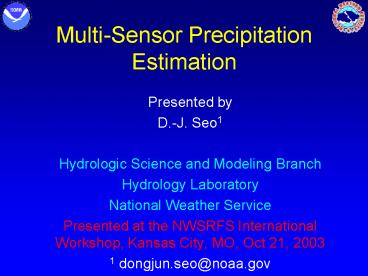Multi-Sensor Precipitation Estimation - PowerPoint PPT Presentation
1 / 31
Title:
Multi-Sensor Precipitation Estimation
Description:
1 free of significant beam blockage. 2 free of ground clutter ... 1 Hydro-estimator (formerly Auto-estimator) product from NESDIS (Vicente et al. 1998) ... – PowerPoint PPT presentation
Number of Views:59
Avg rating:3.0/5.0
Title: Multi-Sensor Precipitation Estimation
1
Multi-Sensor Precipitation Estimation
- Presented by
- D.-J. Seo1
- Hydrologic Science and Modeling Branch
- Hydrology Laboratory
- National Weather Service
- Presented at the NWSRFS International Workshop,
Kansas City, MO, Oct 21, 2003 - 1 dongjun.seo_at_noaa.gov
2
In this presentation
- An overview of multisensor precipitation
estimation in NWS - The Multisensor Precipitation Estimator (MPE)
- Features
- Algorithms
- Products
- Ongoing improvements
- Summary
3
DPA
DHR
WSR-88D
ORPG/PPS
Hydro-Estimator
Rain Gauges
Flash Flood Monitoring and Prediction (FFMP)
Multi-Sensor Precipitation Estimator (MPE)
Lightning
NWP model output
WFO
RFC, WFO
4
Multi-Sensor Precipitation Estimator (MPE)
- Replaces Stage II/III
- Based on
- A decade of operational experience with NEXRAD
and Stage II/III - New science
- Existing and planned data availability from
NEXRAD to AWIPS and within AWIPS - Multi-scale accuracy requirements (WFO, RFC,
NCEP, external users)
5
Stage III versus MPE
- No delineation of effective coverage of radar
- Radar-by-radar precipitation analysis
- Mosaicking without explicit considerations of
radar sampling geometry
- Delineation of effective coverage of radar
- Mosaicking based on radar sampling geometry
- Precipitation analysis over the entire service
area - Improved mean-field bias correction
- Local bias correction (new)
6
Delineation of Effective Coverage of Radar
- Identifies the areal extent where radar can see
precipitation consistently - Based on multi-year climatology of the Digital
Precipitation Array (DPA) product (hourly,
?4x4km2) - RadClim - software for data processing and
interactive delineation of effective coverage
7
Radar Rainfall Climatology - KPBZ (Pittsburg, PA)
Cool season
Warm season
8
Mosaicking of Data from Multiple Radars
- In areas of coverage overlap, use the radar
rainfall estimate from the lowest unobstructed1
and uncontaminated2 sampling volume
1 free of significant beam blockage 2 free of
ground clutter (including that due to anomalous
propagation (AP))
9
Mid-Atlantic River Forecast Center (MARFC)
Height of Lowest Unobstructed Sampling Volume
Radar Coverage Map
10
West Gulf River Forecast Center (WGRFC)
Height of Lowest Unobstructed Sampling Volume
Radar Coverage Map
11
Southeast River Forecast Center (SERFC)
Height of Lowest Unobstructed Sampling Volume
Radar Coverage Map
12
PRECIPITATION MOSAIC
RADAR COVERAGE MAP
13
Mean-Field Bias (MFB) Correction
- Based on (near) real-time hourly rain gauge data
- Equivalent to adjusting the multiplicative
constant in the Z-R relationship for each radar
Z A(t) Rb - Accounts for lack of radar hardware calibration
- Designed to work under varying conditions of rain
gauge network density and posting delays in rain
gauge data - For details, see Seo et al. (1999)
14
From Cedrone 2002
15
MFB and Z-R List
North-Central River Forecast Center (NCRFC)
16
Effect of Mean Field Bias Correction
From Seo et al. 1999
17
Local Bias (LB) Correction
- Bin-by-bin (?4x4km2) application of mean field
bias correction - Reduces systematic errors over smaller areas
- Equivalent to changing the multiplicative
constant in the Z-R relationship at every bin in
real time Z A(x,y,t) Rb - More effective in gauge-rich areas
- For details, see Seo and Breidenbach (2000)
18
Radar under-estimation (local bias gt 1) Radar
over-estimation (local bias lt 1)
19
Local bias-corrected rainfall local bias x raw
radar rainfall
20
Multi-Sensor Analysis
- Objective merging of rain gauge and
bias-corrected radar data via optimal estimation
(Seo 1996) - Reduces small scale errors
- Accounts for spatial variability in precipitation
climatology via the PRISM data (Daly 1996)
21
Multi-Sensor Analysis
22
MULTISENSOR ANALYSIS ALSO FILLS MISSING AREAS
23
Multisensor analysis accounts for spatial
variability in precipitation climatology
July PRISM climatology
24
MPE products
- All products are hourly and on the HRAP grid
(?4x4km2) - RMOSAIC - mosaic of raw radar rainfall
- BMOSAIC - mosaic of mean field bias-
adjusted radar rainfall - GMOSAIC - gauge-only analysis
- MMOSAIC - multi-sensor analysis of
BMOSAIC and rain gauge data - LMOSAIC - local bias-adjusted RMOSAIC
25
Human Input via Graphical User Interface
- Through HMAP-MPE (a part of HydroView)
- Allows interactive
- quality control of raw data, analysis, and
products - adjustment, draw-in and deletion of precipitation
amounts and areas - manual reruns (i.e. reanalysis)
- For details on HMAP-MPE, see Lawrence et al.
(2003)
26
Ongoing improvements
- Quality-control of rain gauge data (Kondragunta
2002) - automation
- multisensor-based
- local bias correction of satellite-derived
precipitation estimates1 (Kondragunta et al.
2003) - Objective integration of bias-corrected
satellite-derived estimates into multisensor
analysis
1 Hydro-estimator (formerly Auto-estimator)
product from NESDIS (Vicente et al. 1998)
27
Satellite-derived estimates fill in radar
data-void areas
West Gulf River Forecast Center (WGRFC)
28
From Kondragunta 2002
29
Merging radar, rain gauge, satellite and
lightning data
From Kondragunta 2002
30
Summary
- Multisensor estimation is essential to
quantitative use of remotely sensed precipitation
estimates in hydrological applications - Built on the experience with NEXRAD and Stage
II/III and new science, the Multisensor
Precipitation Estimator (MPE) offers an
integrated and versatile platform and a robust
scientific algorithm suite for multisensor
precipitation estimation using radar, rain gauge
and satellite data - Ongoing improvements includes multisensor-based
quality control of rain gauge data and objective
merging of satellite-derived precipitation
estimates with radar and rain gauge data
31
Thank you!
For more information, see http//www.nws.noaa.gov/
oh/hrl/papers/papers.htm































